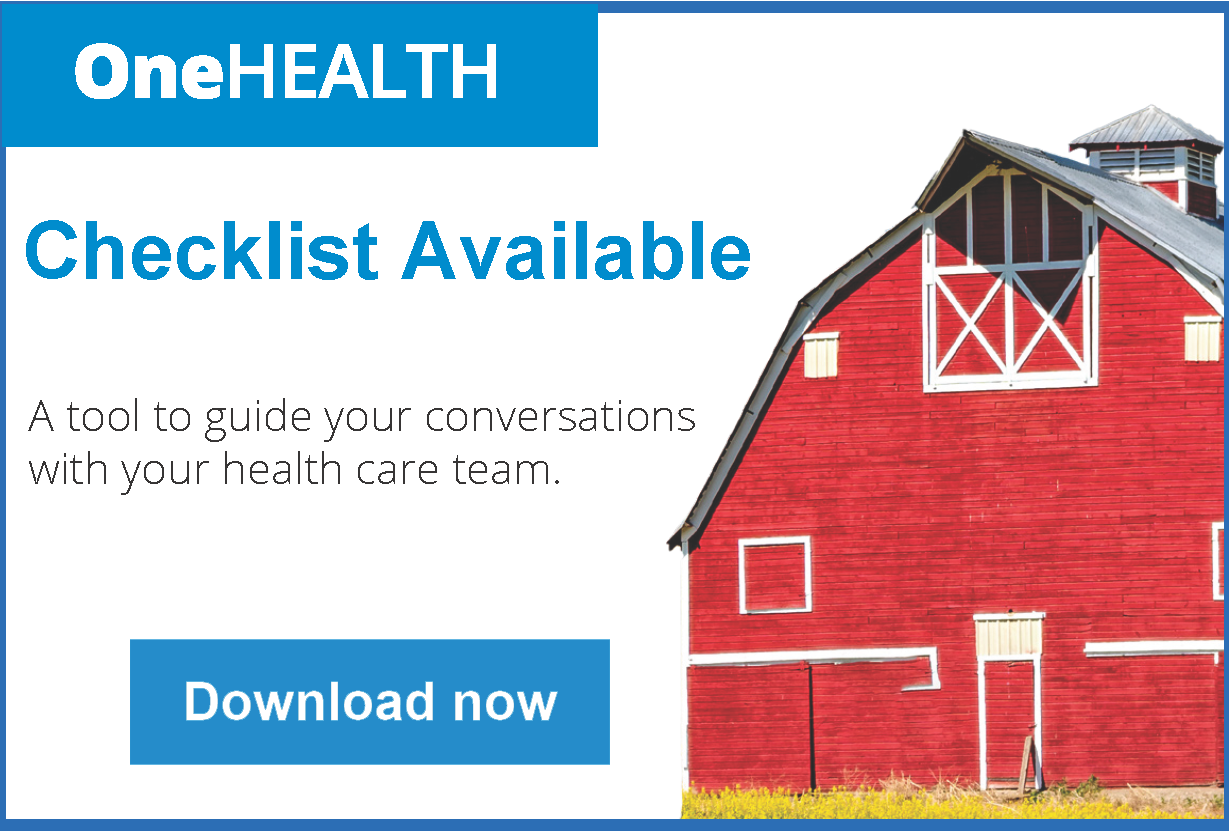One Health
One Health recognizes that the health of people, animals, and the planet are all connected. As part of its mandate, the College supports veterinary initiatives which promote public and animal health and welfare. That is why one of the key components of the current strategic plan is for the College to promote the importance of One Health. One Health considerations can include zoonotic diseases, antimicrobial resistance, food safety and food security, vector-borne diseases, environmental contamination, and other health threats shared by people, animals, and the environment.
Keeping our farm family healthy
Farm families are unique. They often have daily contact with all sorts of animals and environments that increase their exposure and potential risk to diseases. These unique and potential risks are an important consideration in assuring your family's health.
sorts of animals and environments that increase their exposure and potential risk to diseases. These unique and potential risks are an important consideration in assuring your family's health.
The health of your farm family sparked development of a new and easy-to-use checklist that will improve conversations between you and your health care team, which includes veterinarians. With information around animal exposure, zoonotic diseases, water sources and food supply, your health care providers will have a broader awareness and understanding of the potential risks and be equipped to promote better health care for you and your family.
One Health promotional kit
 We have created a kit to help veterinary teams engage clients in One Health conversations.
We have created a kit to help veterinary teams engage clients in One Health conversations.
A One Health approach increases the likelihood of improving the health of people, animals, and our shared environment. By encouraging your companion animal clients to provide more relevant information about their health and environment, you are acting as a One Health champion!
This kit is brought to you by the College of Veterinarians of Ontario, the Ontario Veterinary Medical Association and the Ontario Association of Veterinary Technicians.
What is One Health?
One Health is explained thoroughly in the article below, prepared by the American Veterinary Medical Association (AVMA).
One Health is the integrative effort of multiple disciplines working locally, nationally, and globally to attain optimal health for people, animals, and the environment. Because of their expertise, veterinarians play critical roles in the health of animals, humans, and even the environment, but these roles can be overlooked or unrecognized. Nonetheless, veterinary medicine is the only profession that routinely operates in all three components of One Health and by promoting collaboration across all sectors, this approach can achieve the best health outcomes for all.
The concept behind One Health has existed for centuries – from Hippocrates' "On Airs, Waters, and Places" (estimated 400 BC) to the webpage you're reading today. Some of the greats who have contributed to One Health include individuals such as Giovanni Lancisi, Louis-Rene Villerme, Rudolf Virchow, William Osler, Louis Pasteur, Robert Koch, Rachel Carson, former Assistant Surgeon General James Steele, and Calvin Schwabe, just to name a few. Dr. Schwabe captured the term "One Medicine" in his book, Veterinary Medicine and Human Health, and it was in honor of him that the AVMA's One Health Initiative Task Force (OHITF) dedicated its final report.
As the human population continues to increase and expand across our world, the interconnection of people, animals, and our environment becomes more significant and impactful.
The importance of One Health is highlighted by many factors in our world today:
The world's total population exceeded 7 billion people in 2011, and it continues to climb.
As our population expands geographically, the contact between human and wild animal habitats increases, introducing the risk of exposure to new viruses, bacteria and other disease-causing pathogens.
Advancing technologies and science-based evidence is increasing the awareness, knowledge, and understanding of the interdependency of the health of humans, animals, and the environment.
The human-animal bond continues to grow throughout societies.
It is estimated that at least 75% of emerging and re-emerging diseases are either zoonotic (spread between humans and animals) or vector-borne(carried from infected animals to others through insects).
Vigilant protection of our food and feed supplies from food-borne diseases, contamination, and acts of terrorism is critical for human and animal health.
Contamination by personal care products and pharmaceuticals has been detected in our waters.
Your Veterinarian & Your Health
It is unlikely that a veterinarian is the first person to come to mind when you’re dealing with personal health issues. However, your overall health is connected to your animal’s health in a variety of ways.
The “pet effect” is demonstrated with evidence that having animals in your life may keep you healthy. There is research suggesting that a person may lower their blood pressure simply by petting and talking to a dog. Research also supports the idea that dog owners have a better chance of surviving a heart attack. The research on the animal-human bond is extensive and demonstrates everything from pet owners having less sick days to exposure to pets reducing a child’s risk of developing allergies.
As much as happy, healthy pets contribute to happy, healthy humans, it is also possible for some diseases in animals to lead to human illness. The ability of some disease to infect different animals and then be transmitted into people is something that is carefully monitored by both veterinary and public health professionals.
COVID-19 is one example of a disease that made the jump from an animal to humans. Another example is rabies, which is most commonly spread through bites from rabid animals and can be fatal. Other examples of common diseases associated with pets include cat scratch disease which comes from a bacteria carried by approximately 40 percent of cats. Campylobacteriosis is a disease caused by bacteria which may infect pets and be spread through contact with their feces. Common intestinal or external parasites, such as roundworms, fleas or ticks, can accidentally be transmitted to humans. Infections are typically acquired from bites, scratches or contact with animal saliva, urine, secretions, and feces. Diseases can also be transmitted indirectly through contaminated surfaces. There are more than 70 human diseases which can be attributed to pets as the potential source.
Diseases that are passed from animals to humans are called zoonoses or zoonotic illnesses, and by safeguarding animal health and wellness, veterinarians are also protecting human health. To learn more information about how you can help protect yourself and your pets from zoonotic illnesses, consult with your veterinarian and ensure your animals are on an appropriate infection control program, including vaccinations and parasite control.
Reporting animal bites:
Reporting animal bites is one way veterinarians support public health. Veterinarians are legally required to report all animal bites to their local public health unit so the Medical Officer of Health can assess the potential risk to human health, specifically rabies exposure.
Veterinarians and Public Health
Your veterinarian is part of your public health team. The history and tradition of the veterinary profession have always focused on protecting and improving both animal health and human health.
Reporting diseases:
Antimicrobial Stewardship
Antimicrobial stewardship is a coordinated approach to optimizing the use of antimicrobials, maximizing patient care while minimizing the risk of resistance, toxicity or other adverse events.
The College Council has been demonstrating its commitment to veterinary stewardship and the responsible use of antimicrobials in animals for several years. Council articulated its position on stewardship in a policy document. The College expects veterinarians to assume a leadership role in understanding the need for antimicrobial oversight, the existing government directives, the evolving science related to pharmaceuticals, and the most appropriate current use of antimicrobial drugs. The veterinary profession has a duty to act as a steward with respect to the prudent and responsible use of antimicrobial drugs.
The responsible use of antimicrobials is simple:
Only by prescription
Only when necessary, and
Only at a dosage needed based on evidence
The College will continue to serve the public interest in partnership with provincial, national, and international organizations to combat the spread of antimicrobial resistance and support antimicrobial stewardship.
One Health Library
Reference materials are available to assist with your understanding of One Health.

